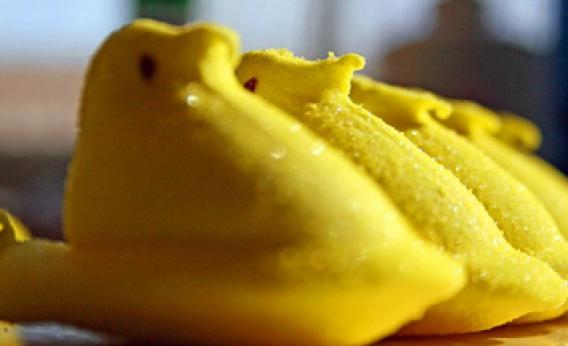Create a free profile to get unlimited access to exclusive videos, sweepstakes, and more!
What Happens When You Throw a Peep Out an Airlock?

Q: What would you hear if you tossed an Easter marshmallow candy out a spaceship’s airlock?
A: Not a peep.
Peeps, the wildly popular sugary marshmallow treats, have little nutritional value and take up a lot of space for their mass, so I wouldn’t imagine they’d be a staple food for astronauts. But if some future space voyage stocked them for the astronauts, instead of eating them it might be a lot more fun to throw them out the airlock.
Why? Because this*:
Every year, the Texas A&M University throws the Physics and Engineering Festival, a weekendlong event with dozens of science demos, talks, and entertainment. I was invited to speak in the evening at the 2014 event and spent the day wandering the halls and grounds of the Mitchell Physics Building and Institute, enjoying myself immensely. It was so much fun to see students enthusiastically run their demos to the huge crowd of people who came from all over the Lone Star State.
The Peep demo was one of the first I saw, and one that made me laugh the hardest. It’s funny, but it’s science!
So what did you just see? Peeps are basically spun sugar, starting as a liquid slurry which gets air whipped into it, and then is extruded by a machine into the familiar chick shape. When the sugar solidifies it’s full of little holes, like a sponge. It then gets spritzed with coloring to give it that healthy neon yellow (or in this case, blue) sheen.
In the demo the Peep is placed on a rubbery surface, the glass bell jar is put over it, and the air pumped out. Air expands to fill whatever volume it is in, pushing on the walls of its container until the pressure is balanced. When the air outside the Peep is removed, the air in the little spongy holes expands to replace it. Because the Peep is soft, the material around the holes gets pushed by the air and expands as well, inflating the Peep overall. The tension in the material itself provides a force that keeps the air from expanding into the jar, so at some point the expansion stops when the forces balance.
However, that material is made of sugar molecules all stuck together in a crystalline state. When the Peep expands, the crystal structure is partially broken, and it stays expanded only because the air pressure inside the bubbles is holding it up, balanced by the tension in the sugar. Once the air is let back into the bell jar the air inside the bubbles contracts again, and the material collapses. That part made me laugh even more than the expansion.
Although changed physically, nothing chemically has changed in the Peep, so they’re still edible. Well, by definition, I suppose. That part of the demo is clear enough, though I wonder how many Peeps physics grad student Leo Alcorn, who ran it, ate over the course of the weekend.
Atmospheric pressure here in Boulder, Colo., is about 18 percent less than at sea level, so I hope she avoided any trips to Colorado before she digested them all. Which makes me wonder … are Peeps in Colorado measurably bigger than ones sold elsewhere?
You’re welcome, Colorado parents and students who are looking for a last minute science fair idea.
*I know, I held my phone vertically and not horizontally, against the laws of nature and science and the 'Net. However, there were lots of little kids wandering around, and I figured it was better to orient the phone portrait mode so they wouldn't be included. Also: Tip o' the bell jar to Leo Alcorn, who was awesomely cool about all this.














